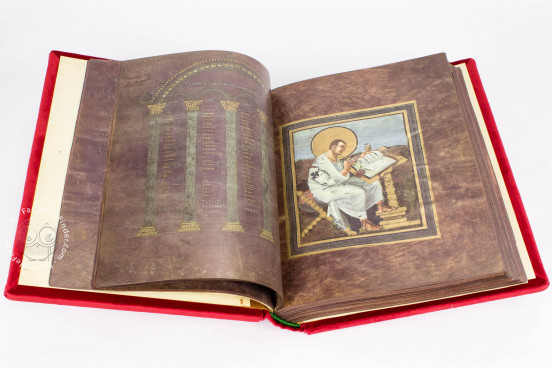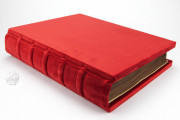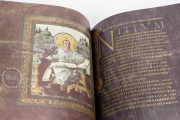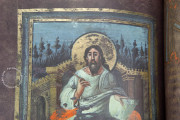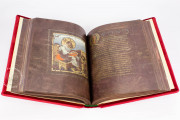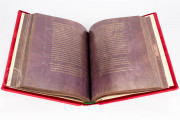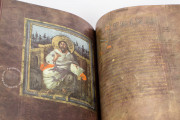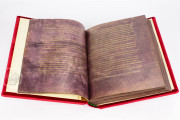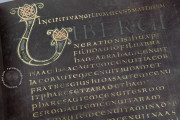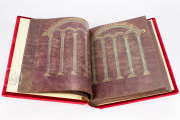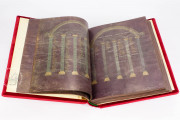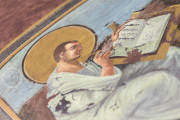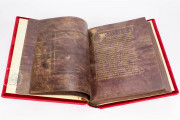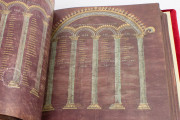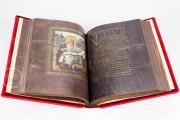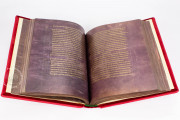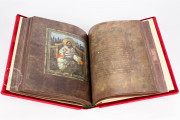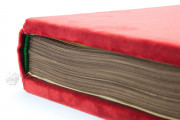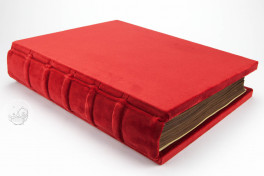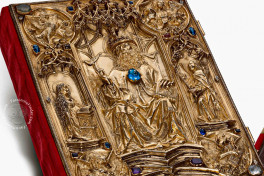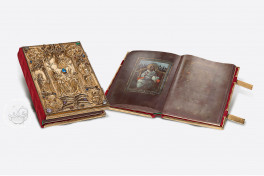One of the grandest works of courtly production from the time of Charlemagne (742-814), the Coronation Gospels was—according to legend—buried with the emperor in his tomb. Made around 800 at the imperial palace at Aachen, it was in use for hundreds of years as the codex upon which the kings and emperors of the Holy Roman Empire took their oaths during their official coronation.
The grandeur of the manuscript certainly merits the central role it was given in these later imperial ceremonies. The Coronation Gospels presents the text of the four Gospel accounts of the life of Christ, preceded by canon tables, with prologues and short biographies of the evangelists, all written in Latin in gold and silver on leaves painted a majestic purple.
Sumptuous Illumination
Each Gospel begins with a portrait of the appropriate evangelist highlighted in gold and set within an ornamented frame. The decorative motifs in the frames are seen also in the imposing arches of the canon table pages, which are set on columns that are painted to mimic exotic green marble.
Evangelist Portraits
The commanding representations of the authors at the beginning of each Gospel are set within cursory landscapes that draw focus to the figures seated on gold thrones with colorful cushions. Clad in voluminous white garments, each evangelist is paired with either a scroll or codex and is spotlighted with a substantial luminous gold halo.
Given the unparalleled nature of these wonderful portraits, several scholars have posited the participation of Byzantine artists in the painting of the miniatures. An inscription in gold at the beginning of the Gospel of Luke names one Demetrius Presbyter ("Priest Demetrius," Demetrius being a Greek name), suggesting a link to the Eastern Roman Empire (fol. 118r).
Codex Aureus et Argenteus
The preciousness of the manuscript extends to the parchment and writing. All the leaves are painted purple in imitation of the mollusk-based imperial Tyrian purple. Like late antique purple codices—such as the Rossano Gospels and the Vienna Genesis—the dignified purple surfaces were written on in gold and silver ink.
Archaizing Rustic Capitals and Square Capitals were used in conjunction with Uncial script, rather than the standard Caroline Minuscule, evoking what the creators believed was the imperial idiom of the ancients.
The Stuff of Legend
According to legend, the Coronation Gospels was discovered in the tomb of Charlemagne when it was opened by Emperor Otto III in the year 1000. As the details of this event vary greatly among later medieval sources, it is unlikely that it occurred. Nevertheless, it is lore that speaks to the cult status of the manuscript and bestowed it with a relic-like status.
An Imperial Gold and Bejeweled Binding
The enchantment of the manuscript culminates in its magnificent binding of gilt silver. A later addition, it was created in 1500 by Hans von Reutlingen, a local Aachener and imperial seal-maker to Holy Roman Emperors Maximilian I (1459-1519) and Charles V (1500-1558). Of exceptional beauty, the relief focusing on God the Father flanked by the Annunciation to the Virgin in niches is fully three-dimensional in some places. The binding includes medallions bearing symbols of the four evangelists. Precious stones are set into the cover, radiating from an especially remarkable sapphire set into the middle of God's chest.
We have 2 facsimiles of the manuscript "Coronation Gospels":
- Krönungsevangeliar des Heiligen Römischen Reiches (Library Edition) facsimile edition published by Faksimile Verlag, 2012
- Krönungsevangeliar des Heiligen Römischen Reiches (Deluxe Edition) facsimile edition published by Faksimile Verlag, 2012

